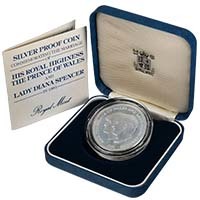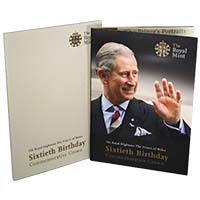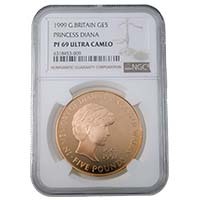
Please Note: This article was published before Prince Charles became King Charles III.
At some point in the future, we'll see Prince Charles' face all over our coinage. What will that effigy look like? The answer right now is we just don't know, but the history of royal numismatic portraits and previous depictions of the Prince of Wales on commemorative Royal Mint coins might give us some clues.
Who Is Prince Charles?
Born in 1948, Prince Charles is the eldest son of Queen Elizabeth II and her husband, the late Prince Philip. As a senior member of the royal family he undertakes official duties on behalf of the Queen and acts as the patron of more than 400 charities and organisations. His own charity, The Prince's Trust, supports vulnerable young people. His other interests include climate change, heritage conservation, the arts and sustainable farming. Charles is also known for his marriage to and subsequent divorce from Princess Diana with whom he had two children: Prince William and Prince Harry.
Charles has been heir apparent to the British throne since his mother became Queen in 1952. He was created Prince of Wales in 1958 and invested in 1969 at Caernarfon Castle. This title was traditionally used by native Welsh royals but has been used by the heir to the British throne for the last few centuries. The current Prince of Wales is both the oldest and the longest serving heir in British history: he was 73 at the time of writing.
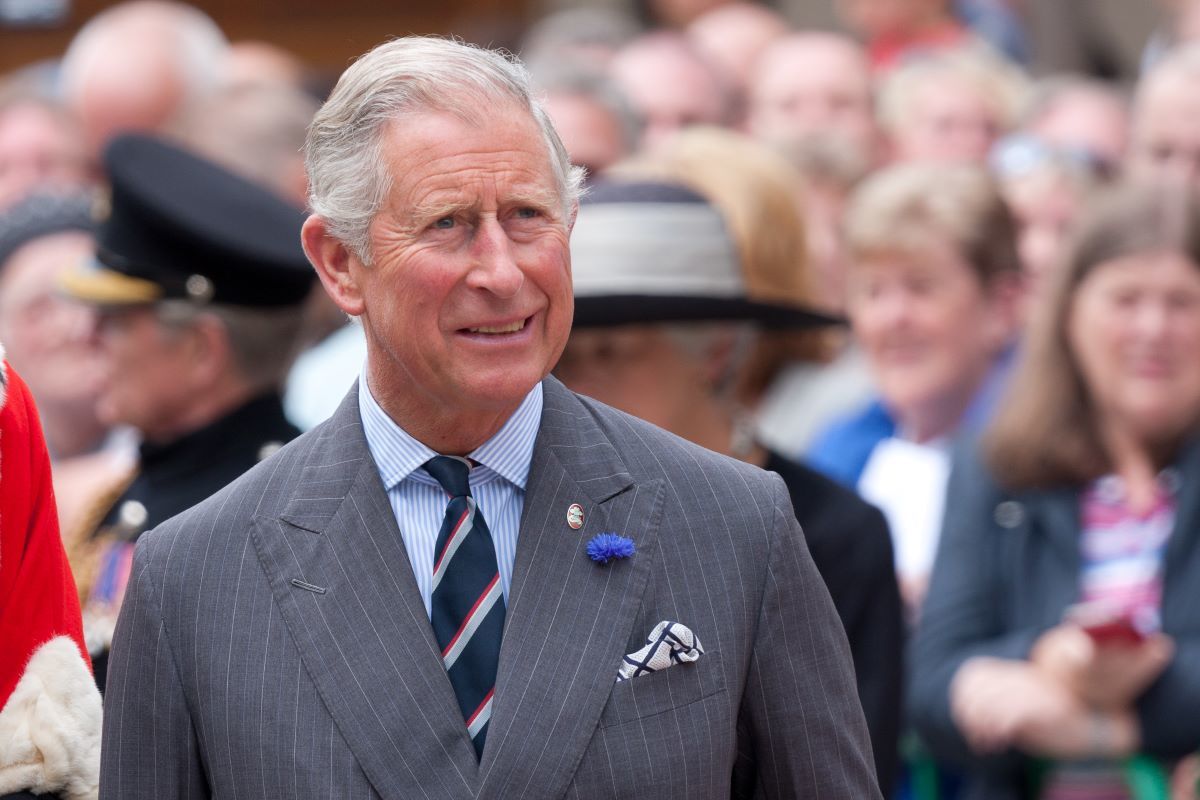
The Prince of Wales in 2012. Dan Marsh / CC BY-SA 2.0.
If Charles keeps his name when he becomes king he will be Charles III. He doesn't have to though. His grandfather, George VI, went by Albert before he ascended the throne in 1937.
Previous King Charles' don't have excellent reputations and a Jacobite pretender very publicly claimed the title 'Charles III' in the eighteenth century. Maybe Prince Charles will choose one of his middle names? Phillip, Arthur or George could work but would it be a bit confusing? We'll have to wait and see.
What Will King Charles III of England's Coin Portrait Look Like?
For the last few hundred years, official coinage portraits have shown British royals in profile, mostly bare-headed or wearing a wreath of laurels. Elizabeth II is shown in her portraits wearing a diadem or crown but will Charles do the same? Charles I appears crowned on his coins and that's not an example any new king will want to follow.
Traditionally, British monarchs face the opposite direction to their predecessors on their coins. This practice dates back to the time of Charles II. Edward VIII would have broken this tradition if his coinage had entered circulation - he reportedly preferred his left side. Maintaining a sense of continuity with his father, George V, after Edward's abdication, King George VI chose to face left on his coinage. His daughter, Elizabeth, faces right so her successor will likely face left, like his grandad.
Elizabeth's first coinage portrait was chosen through an anonymous competition, won by sculptor Mary Gillick. Four subsequent portraits of Elizabeth have been seen on British currency, charting her long reign. New royal portraits will likely be picked in the same way. Entries are assessed by the Royal Mint Advisory Committee and their choice is approved by the Chancellor of the Exchequer and ultimately the monarch themselves.
The current definitive portrait of Elizabeth II is the work of Jody Clark who was an engraver at the Royal Mint when the design was introduced in 2015. Charles' portrait might be created by a Mint employee or another talented artist who can work to the exacting parameters required for circulating coinage.
A monarch's coinage is not issued immediately after they succeed but after their coronation. There will certainly be a gap of several months between Prince Charles' accession and his coronation, allowing time to plan a grand celebration. This means that Charles could acceed his mother in one year and not be crowned until the following one. We'll probably see proof sets and other commemorative issues released to mark the coronation, as well as gradually finding his face in our change in the following months.
What Coins Has Prince Charles Appeared On?
Prince Charles has appeared on four British coins over the last few decades. Each of these has been a commemorative Crown. The Crown no longer circulates in the UK but is often used by The Royal Mint to celebrate royal milestones and anniversaries.
You can find each of these coins in a range of metals and finishes, suitable to every budget.
1981 Charles and Diana Royal Wedding 25p Crown
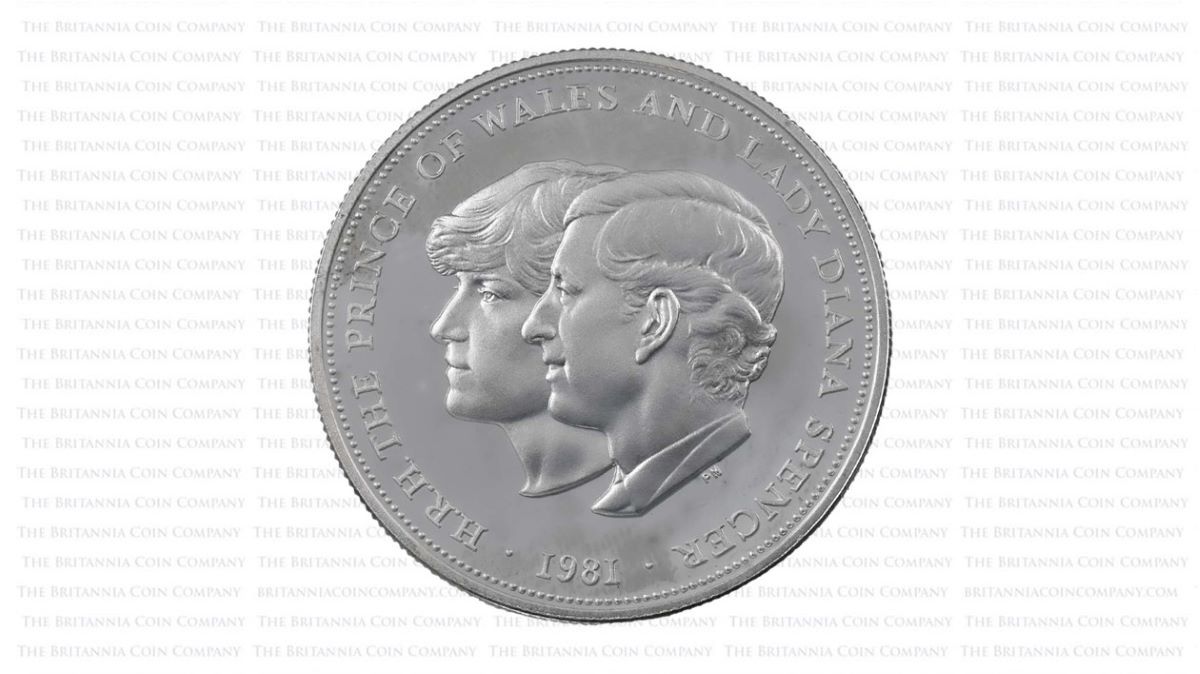
Buy a 1981 silver proof Royal Wedding Crown.
Prince Charles features in a smiling double portrait alongside Lady Diana Spencer on a collectible coin issued to celebrate their 1981 wedding. The couple were married at Westminster Abbey in July of that year in a ceremony televised to an estimated 750 million viewers worldwide.
The conjoined, left facing profiles were crafted by Philip Nathan who might be better known as the artist behind the reverse of most Britannia bullion coins. His initials - PM - appear by Charles' collar. The pair are show 'couped' (the portraits are cropped at the neck) and surrounded by the legend: 'H.R.H. THE PRINCE OF WALES AND LADY DIANA SPENCER' with date below (1981). This is paired with Arnold Machin's youthful third definitive portrait of Elizabeth II to the obverse with a legend reading: 'ELIZABETH II D · G · REG · F · D ·'.
The face value of a Crown coin in 1981 was Twenty Five Pence, prior to the denomination being re-tariffed in 1990 to Five Pounds.
1998 Prince Charles 50th Birthday £5 Crown
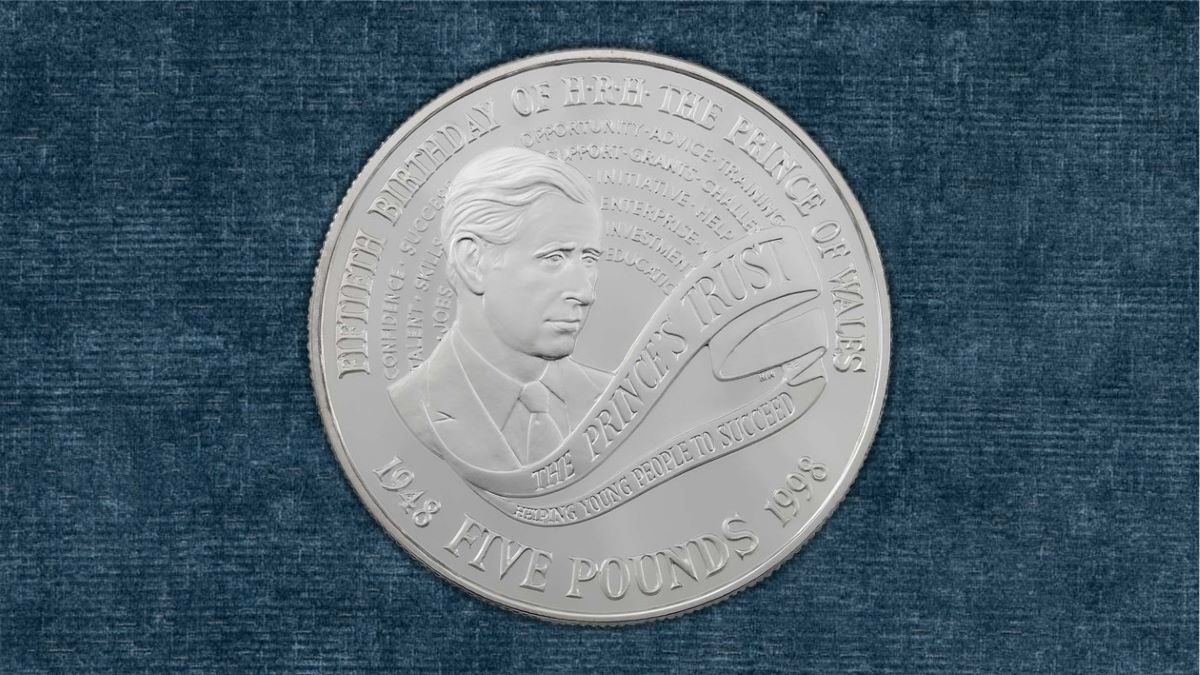
Currently in stock: 1998 Prince Charles coins in BU and silver proof (shown above).
In 1998, Prince Charles celebrated his fiftieth birthday and The Royal Mint marked the occasion with a limited edition Five Pound coin.
The reverse design was a collaboration between portrait painter Michael Noakes and one of the Mint's engravers, Robert Elderton. Their design is a tribute to Charles' charity, The Prince's Trust, founded in 1976. Today, the Trust's mission is to help young people between 11 and 30 get into jobs, education, or training. The fiftieth birthday Crown shows a suited three-quarters portrait of the Prince of Wales above a ribbon reading 'THE PRINCES TRUST. HELPING YOUNG PEOPLE TO SUCCEED.' Behind the Prince's head are words relating to the positive work done by the Trust, including 'advice,' 'enterprise,' and 'confidence'. Around the edge of the reverse is the legend: 'FIFTIETH BIRTHDAY OF HRH THE PRINCE OF WALES · 1948 · FIVE POUNDS · 1998'. Adorning the obverse is Ian Rank-Broadley's effigy of Her Majesty the Queen, introduced in this year.
2008 Prince Charles 60th Birthday £5 Crown
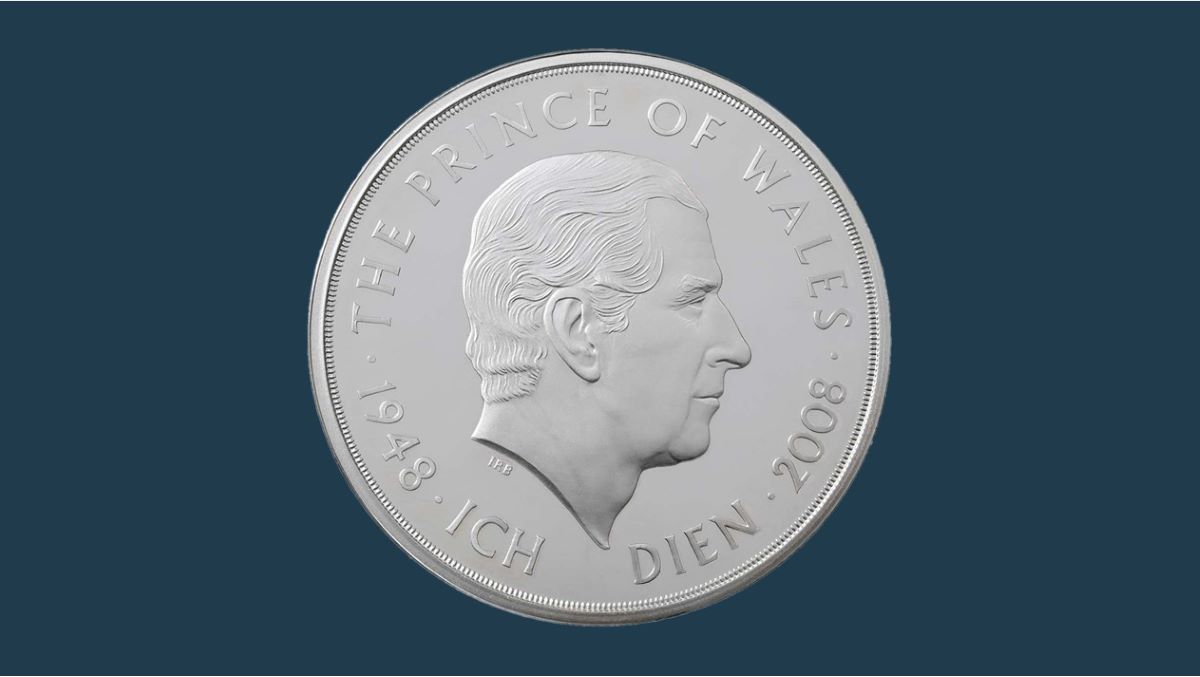
Available now: Prince Charles 60th birthday piedfort Five Pound silver proof coins.
2008 saw another milestone birthday for the Prince, marked with a minimal reverse on another Five Pound Crown.
The obverse of these sixtieth birthday pieces again show Ian Rank-Broadley's portrait of Her Majesty the Queen, facing right. Rank-Broadley is also responsible for the reverse portrait of Charles - distinctly older than when he last appeared on coinage but still highly recognisable. The twin portraits of mother and son make a nice pair with the truncated effigy of Charles bearing some resemblance to the clean-lined, uncrowned portrait of his grandfather, George VI, by Humphrey Paget. The legend 'THE PRINCE OF WALES' appears above with 'ICH DEIN' ('I serve' in German) below. The edge reads 'SIXTIETH BIRTHDAY'.
Interestingly, the portrait faces right, rather than left as Charles' monarchic portrait will. Otherwise, Rank-Broadley's portrait may bear a close resemblance to the design that will feature on the next king's coinage, minus a few more fine lines.
2018 Prince Charles 70th Birthday £5 Crown
.jpg)
The latest portrait of the Prince of Wales to appear on British coinage.
Robert Elderton created the portrait that appears on the 2018 Crown coin that celebrates Prince Charles' seventieth birthday. He also worked on the 1998 50th birthday commemorative coin. This is a simpler design than that one and shows another right-facing portrait of Charles wearing a jacket and tie. The words 'H.R.H. THE PRINCE OF WALES' appear above and '70TH BIRTHDAY' is inscribed below. This is paired with Jody Clark's portrait of Her Majesty to the obverse.
These 2018 Five Pound coins were available in platinum and platinum piedfort, as well as the unusual range of BU, silver and gold options.
It's interesting to see the Prince age through this succession of commemorative coinage. Whenever he succeeds, Charles will start his reign as Britain's oldest new king. These previous portraits may provide an insight into his eventual coinage effigy but who knows? Maybe he'll break the mould and have himself show facing forward, ears in full view? Can we say that?
Sell A Royal Mint Prince Charles Coin
If you've got a commemorative coin with a portrait of Prince Charles on then we would be interested in buying it. Visit our Sell Your Coins page for more information then contact us for a quick quote. We buy commemorative Crowns in BU, gold and silver as well as an extensive range of modern and historic coinage for fair, industry-leading prices.
Frequently Asked Questions
New portraits and reverse designs for British coins are chosen by the Royal Mint Advisory Committee then approved by the Chancellor of the Exchequer and the monarch. For royal portraits a competition is often held with the winning artist seeing their design on currency.
In the past, new portraits for monarchs have been created after they came to the throne and issued in their coronation year. Usually there is a gap between a King or Queen’s accession and their coronation, leaving time for a portrait of Prince Charles to be commissioned.
We will likely see the first coins of Prince Charles in his coronation year, rather than immediately after he becomes king. This might be a year or more after his accession which leaves quite a bit of time before we would see Charles III coins in our change.
There are several Five Pound coins featuring Prince Charles available now in BU, silver, gold and even platinum. A 1981 Crown coin marked his wedding to Princess Diana and recent decades have seen new £5s to celebrate his 50th, 60th and 70th birthdays.
In Britain the tradition is that a monarch faces the opposite direction to their predecessor on their coins. Queen Elizabeth II faces right so Prince Charles will likely face left in his first coinage portrait, issued after he succeeds to the throne.
We buy all commemorative Crowns featuring Prince Charles. 2018 gold and platinum 70th birthday coins were issued in very small numbers and we are particularly interested in buying these coins. Visit our Sell Your Coins page and get a quote for your coins fast.
If you have a Prince Charles Crown coin from 1981, 1998, 2008 or 2018 you would like to sell then contact The Britannia Coin Company now for a free, no-obligation quote. We buy Prince Charles coins in BU, silver, gold and platinum for cash.
Charles II was shown with a crown on his money but since the seventeenth century most British monarchs have been shown either with a bare head or wearing a crown of laurels. Queen Elizabeth II has been shown crowned but Prince Charles might not copy her.
If you have a Prince Charles birthday £5 Crown that you want to sell, contact The Britannia Coin Company now on 01793 205 007. We buy Prince Charles 50th, 60th and 70th birthday coins in silver, gold and BU. Visit our Sell Your Coins page for more details.
The official residence of Prince Charles and his wife Camilla is Clarence House in London. In addition to this he also spends time at Highgrove House near Tetbury in Gloucestershire and maintains properties in Scotland and Wales.
Prince Charles was born at Buckingham Palace in London on 14 November 1948. At this time his grandfather, George VI, was king. His mother would succeed to the throne in 1952 which made the young Prince heir apparent to the British throne.
Prince Charles was 32 years old when he married Lady Diana Spencer at Westminster Abbey on 29 July 1981. Diana was twelve years his junior and just 19 when they announced their engagement. She was 16 when they met at her ancestral home, Althorpe, in 1977.
Prince Charles uses the surname Mountbatten-Windsor, combining the name his father, Prince Philip, adopted when he renounced his Greek titles and the name used by members of the British royal family since 1917. For the most part, as a Prince, he doesn’t need a surname.
Prince Charles will turn 74 on 14 November 2022. He was born in 1948. Prince Charles is the longest serving and oldest heir apparent in British history and will be the oldest person to become monarch when he succeeds his mother, Queen Elizabeth II.
If Prince Charles uses his first name when he becomes king he will be called Charles III. To avoid association with Charles I and Charles II he may choose to go by another name as monarch, perhaps one of his middle names: Philip, Arthur or George.
British monarchs can go by their given name or choose a different one when they ascend to the throne. Prince Charles may wish to avoid association with Charles I and Charles II and may instead use one of his middle names rather than becoming King Charles III.
1981 Crown coins issued to celebrate the wedding of Prince Charles and Princess Diana are available in silver and base metal, similar to the coins in your change. The silver proof coins come in a clamshell box. Looking to sell one of these Diana coins? Contact us now.

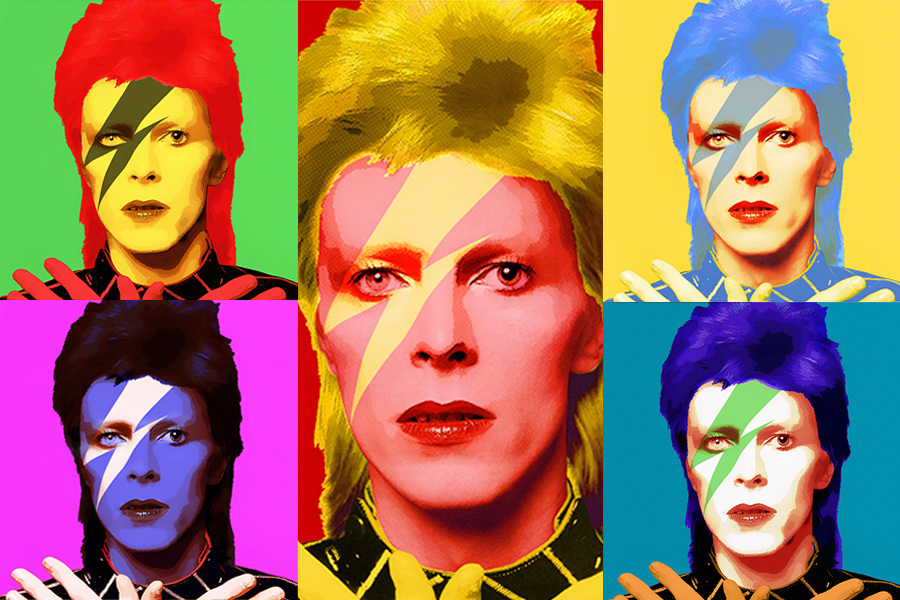
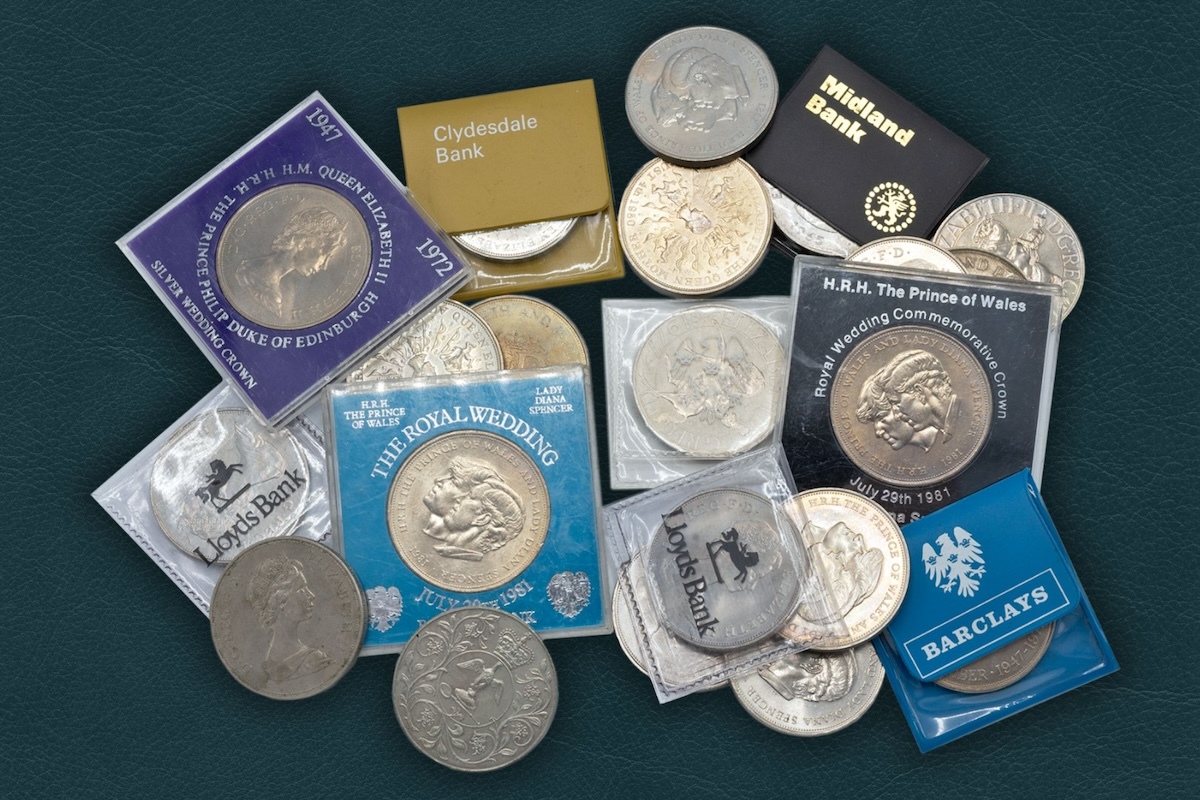
.jpg)
